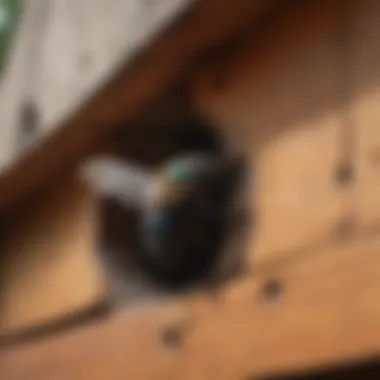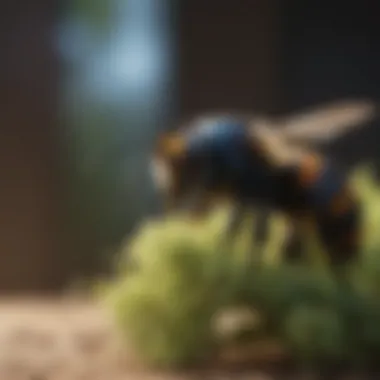Protect Your Property: Effective Remedies for Carpenter Bees Infestation


Interior Design Tips
Carpenter bees, known for their wood-boring habits, can pose a threat to the integrity of your wooden structures. Identifying early signs of infestation is crucial in combatting these pests effectively. Keep an eye out for perfectly round entry holes about ½ inch in diameter on wooden surfaces, along with wood shavings beneath the holes, indicating bee activity. Once you have confirmed an infestation, taking proactive measures becomes essential to prevent further damage.
Organic Pest Control Solutions
Implementing natural remedies to deter carpenter bees can be a sustainable approach to safeguard your property. Consider using citrus-based oils or sprays, like lemon or orange oil, to repel these insects from boring into wood. Another effective solution is the application of almond oil mixed with white pepper powder, creating a potent deterrent for carpenter bees. These natural alternatives offer an eco-friendly way to protect your wooden structures without harmful chemicals.
Prevention and Maintenance Techniques
To maintain a pest-free environment, preventive measures play a significant role in deterring carpenter bees. Sealing any existing entry holes with wood putty and painting or varnishing wooden surfaces can help in reducing attractiveness to these insects. Additionally, installing carpenter bee traps around your property can capture stray bees and minimize the risk of infestations. Regular inspection and maintenance of your wooden structures are essential to detect and address potential issues promptly.
Conclusion
Understanding Carpenter Bees
Understanding Carpenter Bees is crucial in combating potential infestations, especially for homeowners keen on preserving their wooden structures. By delving into the behavioral patterns of Carpenter Bees, individuals can anticipate and address issues proactively. Recognizing the distinct traits and habits of these bees enables a more strategic approach to pest management. Through a detailed understanding of Carpenter Bees, homeowners can effectively safeguard their property and minimize damages.
Behavioral Patterns of Carpenter Bees
Carpenter Bees exhibit specific behavioral patterns that are essential to grasp for effective pest control. Their boring habits involve tunneling into wood to create nests, posing a risk to wooden structures. By comprehending the precise nature of these habits, homeowners can identify infestations early and take appropriate measures. Additionally, understanding Carpenter Bees' nesting preferences is key to locating and eradicating colonies efficiently. This knowledge aids in disrupting their lifecycle and preventing future infestations.
Boring Habits of Carpenter Bees
The boring habits of Carpenter Bees revolve around tunneling into wood to establish nests for their larvae. This behavior contributes to structural damages in wooden elements, necessitating prompt intervention. The key characteristic of this habit is its ability to weaken wood over time, leading to structural instability. While complex and detrimental to wooden structures, these boring habits provide Carpenter Bees with a secure environment for their offspring. Recognizing and addressing these habits is essential in preserving the integrity of wooden constructions.
Nesting Preferences
Carpenter Bees exhibit distinct nesting preferences, favoring unpainted or weathered wood for their colonies. This preference stems from the bees' inclination towards soft and untreated wood, facilitating nest excavation. The unique feature of nesting preferences lies in their selectivity for certain types of wood, increasing the likelihood of infestation in specific areas. Awareness of these preferences allows homeowners to identify vulnerable sections of wood and apply targeted protective measures. While advantageous for bee reproduction, these nesting preferences pose challenges for property owners in preventing infestations.
Damage Caused by Carpenter Bees
Understanding the damage caused by Carpenter Bees is vital for evaluating the extent of harm to wooden structures. By recognizing the structural impacts and aesthetic damages incurred, individuals can prioritize remedial actions. Assessing the consequences of Carpenter Bees' activities allows for comprehensive mitigation strategies and long-term protection measures.
Structural Impacts
Carpenter Bees inflict notable structural impacts on wooden elements through their tunneling activities. These impacts compromise the integrity of wood, potentially resulting in safety hazards and structural failures. The key characteristic of these structural impacts is their progressive nature, with damages accumulating over time. While detrimental, these impacts serve as indicators of infestations, prompting timely interventions to prevent further deterioration. Understanding the severity and implications of structural damages is essential for mitigating risks and preserving wooden structures.


Aesthetic Damages
In addition to structural concerns, Carpenter Bees cause aesthetic damages that detract from the visual appeal of wooden surfaces. These damages manifest as holes and discoloration, affecting the overall appearance of structures. The key characteristic of aesthetic damages is their impact on the aesthetic value of wood, necessitating restoration efforts for cosmetic purposes. While not compromising structural integrity, these damages detract from the quality and visual coherence of wooden features. Addressing aesthetic damages is essential for maintaining the pristine appearance of wooden surfaces and enhancing property aesthetics.
Identifying Carpenter Bee Infestations
Identifying Carpenter Bee Infestations is a crucial aspect in addressing pest issues in residential settings. By recognizing the signs early on, homeowners can take proactive measures to safeguard their wooden structures from potential damages. This section sheds light on the significance of identifying carpenter bees' presence and provides insights into effectively detecting infestations.
Signs of Carpenter Bee Infestations
Wood Shavings
Wood shavings are a common indicator of carpenter bee infestations. These shavings result from the bees' excavation activities as they bore into wooden surfaces to create their nests. The presence of these fine particles near wooden structures signifies ongoing bee activity. While wood shavings may seem innocuous at first glance, they can serve as a major red flag for homeowners, prompting further investigation and prompt action to mitigate the infestation.
Presence of Holes
The presence of perfectly circular entry holes in wooden exteriors is another telltale sign of carpenter bee infestations. These entrance points are typically around half an inch in diameter and serve as the bees' access to their nesting sites within the wood. These holes distinguish carpenter bee activity from that of other wood-boring pests, making them a crucial detail to note during inspections. Homeowners should monitor these holes for signs of fresh activity, such as bees entering or exiting, to gauge the extent of the infestation and determine the appropriate course of action.
Distinguishing Carpenter Bees from Bumblebees
Physical Characteristics
Distinguishing carpenter bees from bumblebees involves noting specific physical traits unique to each species. Carpenter bees are typically larger in size than bumblebees and have a shiny, black abdomen. Their appearance, coupled with a relatively hairless body, sets them apart from their fuzzy bumblebee counterparts. By familiarizing themselves with these distinguishing features, homeowners can accurately identify the type of bee infesting their property, leading to targeted treatment and management approaches.
Behavioral Contrasts
Behavioral contrasts between carpenter bees and bumblebees offer additional insights into their respective nesting habits. Unlike bumblebees that establish colonies underground, carpenter bees prefer to inhabit existing wooden structures. Moreover, carpenter bees exhibit solitary nesting behaviors, with each female creating her individual tunnels within wood. Understanding these behavioral differences enables homeowners to tailor their pest control strategies to effectively address carpenter bee infestations without adversely affecting beneficial bumblebee populations in the vicinity.
Preventive Measures for Carpenter Bee Infestations
In the fight against carpenter bee infestations, preventive measures play a crucial role in preserving wooden structures and maintaining a pest-free environment. By implementing appropriate strategies, homeowners can safeguard their cherished belongings from the destructive activities of these wood-boring insects. Preventive measures encompass a range of techniques aimed at deterring carpenter bees from nesting and causing damage. By understanding the significance of preventive measures, individuals can proactively protect their property against infestations, saving both time and money in the long run.
Protective Coatings and Treatments
Painting Techniques
Painting techniques serve as a fundamental method in protecting wooden surfaces from carpenter bee damage. The application of high-quality paint not only enhances the aesthetic appeal of structures but also creates a physical barrier that deters bees from bore into the wood. The key characteristic of painting techniques lies in their ability to seal and defend wooden surfaces, preventing bees from accessing the material. This protective measure is a popular choice due to its effectiveness in reducing the risk of infestation while enhancing the longevity of wooden structures. However, it is essential to note that regular maintenance and inspection are necessary to ensure the continued efficacy of the paint in deterring carpenter bees.
Wood Sealants


Wood sealants provide another layer of defense against carpenter bee infestations by sealing the pores and cracks in wooden surfaces. The key characteristic of wood sealants is their ability to penetrate and fortify the wood, making it less susceptible to bee intrusion. This popular choice offers added protection against moisture damage and fungal growth, further preserving the integrity of wooden structures. The unique feature of wood sealants lies in their long-lasting effects and versatile application on various wooden surfaces. While the advantage of using wood sealants is evident in their protective properties, it is crucial to acknowledge the importance of proper application and maintenance to maximize their effectiveness.
Natural Deterrents
Citrus-based Repellents
Citrus-based repellents are natural solutions that act as effective deterrents against carpenter bees. The key characteristic of citrus-based repellents is their strong scent, which repels bees and discourages them from nesting in treated areas. This beneficial choice for homeowners seeking environmentally friendly options offers a non-toxic and sustainable approach to pest control. The unique feature of citrus-based repellents lies in their ability to deter multiple insect species while leaving a pleasant citrus aroma. While the advantages of using citrus-based repellents are notable, it is essential to reapply the solution periodically to maintain its potency and effectiveness.
Essential Oil Solutions
Essential oil solutions provide a versatile and natural method for repelling carpenter bees from wooden structures. The key characteristic of essential oil solutions is their potent aroma, which disrupts the bees' communication and foraging patterns, deterring them from infesting the area. This popular choice for eco-conscious homeowners offers a non-intrusive yet effective way to protect against bee activity. The unique feature of essential oil solutions lies in their diverse range of scents, allowing individuals to choose options that align with their preferences while repelling pests. While the advantages of essential oil solutions are significant, proper dilution and application techniques are necessary to ensure optimal repellent effects.
Physical Barriers and Exclusion Methods
Mesh Screens
Mesh screens constitute a physical barrier that prevents carpenter bees from accessing or nesting in vulnerable areas. The key characteristic of mesh screens is their ability to block bee entry while allowing for adequate airflow and visibility. This beneficial choice for homeowners seeking non-invasive solutions offers a durable and versatile method of protection. The unique feature of mesh screens lies in their adaptability to different architectural designs and spaces, providing a seamless integration with existing structures. While the advantages of using mesh screens are evident, regular inspections and repairs are crucial to maintaining their effectiveness in excluding carpenter bees.
Plugging Entry Points
Plugging entry points involves sealing off cracks, holes, or gaps in wooden structures to prevent carpenter bee intrusion. The key characteristic of plugging entry points is their capacity to eliminate potential nesting sites and entryways for bees. This advantageous choice offers a straightforward yet effective solution to deter bee activity and protect wooden surfaces. The unique feature of plugging entry points lies in their immediate impact on reducing the risk of infestation, providing homeowners with peace of mind. While the advantages of using this method are clear, periodic maintenance and resealing may be necessary to uphold the integrity of the barriers over time.
Non-lethal Remedies for Carpenter Bees
In this section of the article, we delve into the significance of non-lethal remedies for carpenter bees, showcasing their crucial role in combatting infestations without causing harm. Non-lethal remedies focus on finding solutions that deter these wood-boring insects effectively while prioritizing environmental and ethical considerations. By employing non-lethal approaches, homeowners can address carpenter bee issues sustainably, seeking to maintain a balance between pest control and wildlife conservation.
Traps and Deterrence Techniques
Homemade Trap Designs
When it comes to homemade trap designs for carpenter bees, simplicity and effectiveness are key. These traps typically involve using easily accessible materials to construct devices that lure and capture carpenter bees without resorting to harmful chemicals. The main advantage of homemade traps is their affordability and adaptability to different infestation levels. While they may not be as sophisticated as commercial traps, their DIY nature allows homeowners to customize and optimize their trapping strategy based on specific needs.
Vibrational Deterrents
Vibrational deterrents offer a unique approach to deter carpenter bees by disrupting their nesting behaviors through sound or vibration. This technique capitalizes on the sensitivity of carpenter bees to certain frequencies, deterring them from nesting in treated areas. The key characteristic of vibrational deterrents lies in their non-invasive nature, providing a chemical-free and environmentally friendly solution to carpenter bee infestations. While their effectiveness may vary depending on environmental factors, vibrational deterrents serve as a novel addition to non-lethal pest control methods.
Distraction Tactics


Providing Alternative Nesting Sites
Providing alternative nesting sites involves creating designated areas away from structures susceptible to carpenter bee infestations. By offering natural or artificial nesting sites designed to attract carpenter bees, homeowners can divert these insects from damaging wooden structures. The key characteristic of this tactic is its focus on redirecting carpenter bees to more suitable locations, reducing the likelihood of infestations in residential areas. While establishing alternative nesting sites requires careful planning and maintenance, the long-term benefits of preserving property integrity make it a valuable strategy.
Use of Decoys
The use of decoys presents a visual deterrent method to dissuade carpenter bees from nesting in preferred locations. Decoys mimic the appearance and characteristics of natural nesting sites, effectively tricking carpenter bees into choosing these simulated locations over actual wooden structures. The key feature of decoys lies in their ability to redirect carpenter bee behavior through visual cues, providing an innovative way to protect valuable property from infestation. While decoys may require periodic monitoring and adjustment, their non-invasive nature and potential for long-term success make them a promising component of distraction tactics against carpenter bees.
Professional Intervention and Expert Consultation
When combating a carpenter bee infestation, the expertise and guidance of professionals are crucial. Professional intervention and expert consultation play a vital role in ensuring the effective management of this pest problem. Seeking help from professionals with experience in dealing with carpenter bees can save homeowners time, effort, and potential damage to their property.
Professional intervention provides a systematic approach to evaluating the extent of the infestation and determining the appropriate course of action. These experts have the knowledge and tools to identify the severity of the infestation and implement targeted solutions. By entrusting the task to professionals, homeowners can rest assured that the carpenter bee issue is being handled with precision and expertise.
Expert consultation offers valuable insights into the behavior and habits of carpenter bees. Professionals can assess the structural vulnerabilities of the property and recommend preventive measures to deter future infestations. Their recommendations are based on a thorough understanding of carpenter bee biology, enabling them to tailor their strategies to each specific case.
Collaborating with pest control specialists ensures a comprehensive approach to carpenter bee infestations. Professionals can offer customized solutions that address the unique challenges posed by these wood-boring insects. Their integrated pest management techniques combine both prevention and treatment methods to effectively deal with carpenter bee problems.
When to Seek Professional Help
Extent of Infestation
Determining the extent of a carpenter bee infestation is a critical factor in deciding when to seek professional help. The size of the infestation can vary from minor to severe, with implications for the immediate surroundings and structural integrity. Identifying the extent of the infestation requires a detailed inspection of the affected areas to assess the scale of the damage.
A professional evaluation of the infestation's extent provides homeowners with a clear understanding of the scope of the problem. This assessment guides the development of a targeted treatment plan that addresses the specific needs of the property. Professionals can accurately gauge the severity of the infestation and recommend appropriate interventions to control and eradicate the carpenter bee population.
Structural Integrity Concerns
Structural integrity concerns arise when carpenter bees compromise the stability of wooden structures through their nesting activities. These insects bore tunnels into wood, weakening its strength and durability over time. Structural damage caused by carpenter bees can jeopardize the safety and longevity of the affected components.
Addressing structural integrity concerns requires prompt action and expert intervention to prevent further deterioration. Professionals are equipped to assess the structural damage caused by carpenter bees and devise strategies to reinforce weakened areas. By addressing these concerns proactively, homeowners can protect their property from extensive harm and preserve its structural integrity.
Consulting Pest Control Services
Inspection Procedures
Engaging pest control services involves thorough inspection procedures to identify carpenter bee infestations accurately. Inspectors examine the property for signs of bee activity, such as holes and wood shavings, to determine the extent of the infestation. Through meticulous inspection procedures, professionals can locate nests and assess the level of risk posed by the infestation.
Inspection procedures play a crucial role in developing an effective treatment plan tailored to the specific conditions of the property. Pest control experts use their findings from the inspection to recommend targeted solutions that address the infestation while minimizing environmental impact. By adhering to comprehensive inspection protocols, professionals can ensure the thorough elimination of carpenter bee populations.
Effective Treatment Options
Choosing the right treatment options is essential in combatting carpenter bee infestations effectively. Pest control services offer a range of treatment methods, including insecticides, dust applications, and nest removal, to eradicate bees and prevent future infestations. Effective treatment options are selected based on the severity of the infestation and the structural considerations of the property.
Professionals recommend treatment options that align with homeowner preferences and property requirements. They employ safe and efficient techniques to eliminate carpenter bees while safeguarding the health and well-being of occupants. By opting for professional treatment services, homeowners can ensure long-term protection against carpenter bee infestations and maintain the integrity of their wooden structures.







